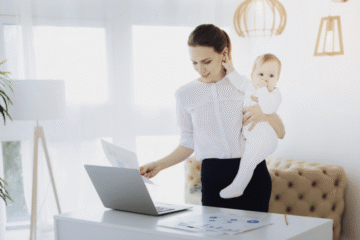For many women, maternity leave is the first major career break they take—and with it comes a mix of excitement, questions, and plenty of planning. From understanding your rights at work to managing your health and finances, preparing for maternity leave isn’t just something that happens in the final trimester.
At eairwoman, we’re here to help you take a proactive approach, empowering you to plan early, feel informed, and step into this next chapter with confidence.
So, how early should you start planning your maternity leave? The answer: as early as possible. Here’s what you need to know.
Why Planning Ahead Matters
The earlier you begin maternity leave planning, the more time you have to:
- Understand your workplace entitlements
- Inform your employer with the required notice
- Manage your superannuation and savings
- Organise your personal and medical support
While some women begin planning once they’re pregnant, others benefit from starting even earlier—during the pre-pregnancy stage—especially when it comes to finances, health, and insurance.
As Health NSW outlines, early preparation helps reduce stress and supports better outcomes for you and your baby.

When Can You Start Planning Maternity Leave?
Technically, you can begin planning as soon as you know you want to have a child but most women start once their pregnancy is confirmed and a due date is established.
Here’s a general timeline to guide your planning:
Early Pregnancy (Weeks 4–12)
- Understand your employment entitlements
- Start budgeting for time off work
- Research your employer’s leave policy and the Australian Government’s Paid Parental Leave scheme
Mid-Pregnancy (Weeks 13–24)
- Inform your employer (Fair Work requires a minimum of 10 weeks’ notice before your intended leave date)
- Begin planning how long you’d like to take off
- Check your superannuation and start thinking about any career breaks
Late Pregnancy (Weeks 25–40)
- Finalise your leave and return-to-work dates
- Apply for Paid Parental Leave through myGov (you can do this up to 3 months before your due date)
- Consider flexible work arrangements for after baby arrives
For more details on preparing for maternity care in Australia, Healthdirect offers a helpful guide.
Using the eairwoman App to Plan Maternity Leave
Planning your leave is about more than marking a date on the calendar. It’s about understanding the bigger picture, especially when it comes to your finances and future savings.
The eairwoman app makes this easier with our powerful “What-If” scenario calculator. This tool lets you explore how maternity leave, whether it’s a few months or a longer break, might impact your:
- Superannuation balance
- Long-term retirement plan
- Financial wellbeing
You can test different return-to-work dates, part-time scenarios, or voluntary super contributions to see how each decision affects your future.
The earlier you start using the app, the more clarity you’ll have when making those big decisions.
What Else Should You Consider?
Beyond work and money, maternity leave planning also means looking after your health, wellbeing, and support systems. Here are a few more things to think about:
- Medical appointments: Book early and follow a regular schedule with your GP or maternity care provider.
- Support networks: Begin building your village, whether it’s a partner, family, or online mums’ groups.
- Mental health: Consider how maternity leave may affect your identity and wellbeing and prepare resources ahead of time.
You can also explore Pregnancy, Birth and Baby for more guidance around preparing emotionally and practically for life with a newborn.

In Summary
Planning maternity leave early helps ease stress and puts you in the driver’s seat. Whether you’re newly pregnant or still considering your options, it’s never too soon to start thinking ahead.
With the eairwoman app, you’ll get the tools and insights you need to prepare financially, understand your super, and make confident choices about your leave.
Download the app today and take the first step in planning your maternity leave with clarity and care.
Got questions about how maternity leave affects your future savings? Contact us—we’re here to help.





